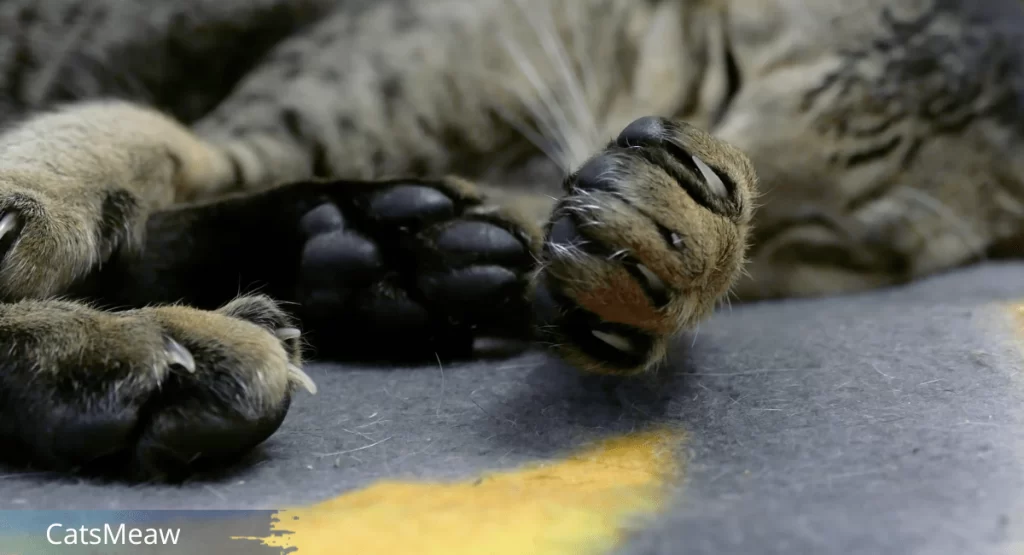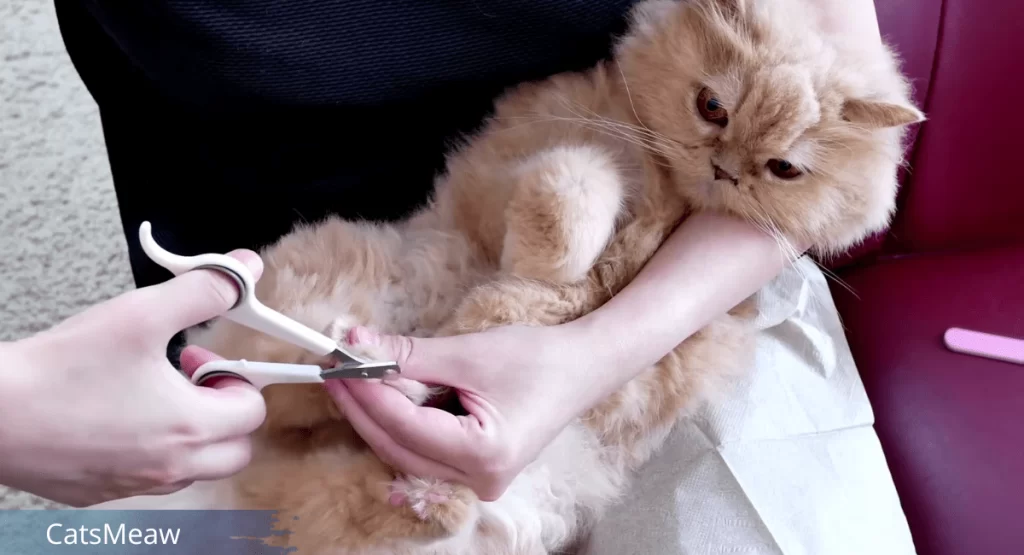Cat’s claws are fascinating and multifunctional tools that play a crucial role in their daily lives. Beyond their obvious use in hunting and self-defense, claws are essential for climbing, marking territory, and maintaining balance. These sharp, retractable appendages also aid in grooming, allowing cats to keep themselves clean and healthy.

Understanding the various functions of a cat’s claws can provide valuable insight into their behavior and needs, helping cat owners better care for their feline friends.
Table of Contents
Multifunctional claws…
Cat’s claws have four functions:
- Chase
- Mark your territory
- To fight, to defend oneself
- Climb
They are therefore very important for your cat who will keep them clean and sharp by making its claws on various supports in its habitat (scratching posts, pieces of wood, carpets, etc.)
As a general rule, the cat takes advantage of its outings to scratch trees and other posts. However, it may also be tempted to scratch the curtains or furniture in the house. In which case, to redirect this need, you will need to provide a substitute, such as a scratching post, or a cat tree with sisal posts. Placed in the right places, your cat will love it!
If the problem persists, you can trim or have your cat’s nails trimmed. The safest thing to do is to consult a veterinarian. If you want to do it yourself, you should know that the cat’s claws consists of a sharp white tip that must be cut in a straight line and a pink part where the blood vessels are located which must absolutely not be cut. to touch.
The usefulness of claws
When the cat walks, its claws do not touch the ground because they are in the retracted position and only the pads are in contact with the ground. The claws are formidable for animals and humans because they are very sharp. Please note, however, that the cat normally only takes them out to climb or defend itself.
It is also quite important to remember that the cat has the habit of scratching sofas, curtains and tapestries if it does not have a tree in the garden.
To avoid damage to the furnishings of the apartment, simply buy a board (on sale in pet stores) on which it can sharpen its claws as it wishes.
Cutting your cat’s claws
The claws of indoor cats and older cats may need to be trimmed at least once a month
If your cat spends a lot of time outside, they walk on rough surfaces, like dirt, and don’t need you to trim their nails. On the other hand, the claws of indoor cats and older cats may need to be trimmed at least once a month. This will prevent them from curling into the pads, causing pain and infections.
Related: Best Guide to Trimming Your Cat’s Nails
Some tips to make cutting your cat’s nails as comfortable and natural as possible:
- Get your cat used to the nail trimming ritual from an early age. At first, pretend to cut them by applying light pressure to your kitten’s fingers.
- You can shorten a kitten’s claws that are still a little soft simply by filing them. There will be less risk of pain or bleeding.
- Check your cat’s claws once a week. If they appear when the cat is resting when they should be fully retracted, they need trimming. Generally, it is the claws on the hind legs that need it the most.
How to go about it right
For adult cats, use suitable nail clippers found in pet stores and maintain them carefully to keep them sharp.
Step 1
Gently squeeze your cat’s paw pads between your thumb and index finger to pop the claw out. Cut only the transparent tip of the claw, which does not contain any vessels.

If you are not used to it, you can injure your cat by cutting into the pulp, the sensitive part which is located near the base of the claw. Ask your groomer or veterinarian to show you how to do this if you are unsure.
2nd step
Prepare silver nitrate sticks (ask your vet) and cotton balls in case you accidentally nick the pulp. In this case, and if the cat’s claws is bleeding, do not panic. Apply silver nitrate calmly and press with a cotton ball for a while.
Silver nitrate can burn, ask for help holding your cat if necessary.
Consult your veterinarian if the bleeding does not stop.
When you check your cat’s claws, take the opportunity to check that the pads have no cuts or foreign bodies. Check between your fingers for any signs of pain. Contact your veterinarian if you notice anything unusual.
What are cat’s claws for?
The cat has retractable claws, that is to say, it is capable of externalizing them only when necessary. In the wild, it uses it to climb trees, to hunt, or to escape when danger presents itself.
Outside of these moments, the last phalanx of the finger, the one that carries the claw, is folded and the claw does not come out.
My cat gets stuck in the carpet and scratches my furniture: can I cut its claws?
Yes and no. Indeed, scratching behavior is normal behavior in cats. It is therefore necessary to provide your cat with a support (scratching post or cat tree) so that it can express this need.
If your cat doesn’t leave your apartment, you can definitely trim its claws. So they are no longer as sharp.
If you go on vacation and your cat has to go out at that time, do not cut its claws in the month before your departure.
On the other hand, if your cat has access to the outdoors, whether it is an enclosed courtyard or a more open garden, its claws are essential.
It is one of your cat’s only means of defense and the only way for it to climb to escape in case of danger.
What equipment to cut cat’s claws in practice?
The claw is made of keratin (like our nails) so you need an instrument capable of cutting the cat’s claws. For this we recommend that you use nail clippers. It is also called a nail clipper but has a different shape from that used for our own nails.
This instrument has the advantage of cutting cleanly and precisely, which allows you to be quick and not split the claw. There are several models, choose the one you have best on hand.
I have the nail clipper, what should I do?
The younger your cat is used to it, the easier this will be to do.
First of all, prop your cat up against you, either on a table or on your lap. You can also get help from someone who holds it still.
With your less skilled hand (the left if you are right-handed for example), gently press on the base of the finger so as to exteriorize the claw. With your other hand, slide the nail clippers over the claw, taking care to avoid the pink triangle that can be seen through transparency. This area is actually hollow and contains blood vessels.
Once the nail clipper is correctly positioned, cut the claw. Repeat the operation on all the claws. Your cat has 5 claws on its front paw and 4 on its back. The rear claws are less curved and less sharp.
Don’t forget to reward your cat with caresses, or even a small treat.
Cat’s claws, just like our nails, grow back. It will therefore be necessary to repeat the operation every month or every 2 months.
My cat won’t let it happen!
Impossible to practice because your cat won’t let it happen? First of all, know that the more you apprehend this moment, the more your cat will feel this tension. So he’ll be really defensive.
Take it gradually. Start with one claw, praise it generously and start again for 2 claws the next day.
Nothing to do, your cat continues to refuse to have its claws cut? Make an appointment with your veterinary clinic, the veterinary assistant will be able to carry it out in optimal safety conditions for your cat and you.
Are claw guards an alternative to claw trimming?
For several years, there have been small plastic sheaths that can be glued to each claw with a special veterinary glue.
These claw protectors are available in several colors. They can be fixed either at home (if your cat is calm and docile) or at your veterinarian.
This alternative still remains more expensive than purchasing a nail clipper that can be reused almost endlessly!
And the definitive removal of claws?
Permanent claw removal, also called onyxectomy or “declawing”, is a practice strictly prohibited in France and many other countries.
In fact, this operation consists of amputating the cat not only of its claw, but also of the 3rd phalanx of its finger since the claw is attached to this bone. This surgery is heavy, cruel and painful!
Related: Infected Cat Claws: Causes & Best Treatment
A cat having undergone this operation would find itself completely vulnerable to dangers.
Remember that even with shortened claws, your cat will maintain its clawing behavior. To preserve your favorite armchair, offer it a cat tree in the room where the cat spends most of its time.
